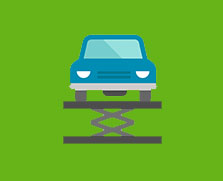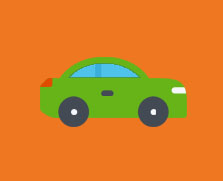Nissan Leaf MOT Results
Registered in 201787.2% pass rate
from 5,130 tests in 2021
Pass rate by mileage
More MoT Results
Failure rates by item
Here you can drill down into the failure rates for each item on the test. We've also compared the rates to the average results for 2017 cars and highlighted areas where the Nissan Leaf is unusually good or bad.
-
4.5% fail on
Visibility
(21% worse than other 2017 cars)
- 3.7% fail on Wipers (35% worse than other 2017 cars)
- 0.86% fail on Washers
-
0.019% fail on
Condition of glass
- 0.019% fail on Windscreen
-
0.019% fail on
View to rear
- 0.019% fail on Mirrors
-
3.9% fail on
Tyres
- 2.7% fail on Condition (39% worse than other 2017 cars)
- 1.2% fail on Tread depth
- 0.039% fail on Size/type
-
2.0% fail on
Brakes
-
1.2% fail on
Brake performance
(160% worse than other 2017 cars)
-
0.84% fail on
Service brake performance
(200% worse than other 2017 cars)
-
0.84% fail on
Rbt
(2 times worse than other 2017 cars)
- 0.80% fail on Service brake performance (2 times worse than other 2017 cars)
- 0.097% fail on Service brake imbalance
-
0.84% fail on
Rbt
(2 times worse than other 2017 cars)
-
0.37% fail on
Parking brake efficiency (sp)
(200% worse than other 2017 cars)
- 0.37% fail on Rbt (sp) (2 times worse than other 2017 cars)
-
0.25% fail on
Parking brake performance
(4 times worse than other 2017 cars)
-
0.23% fail on
Rbt
(4 times worse than other 2017 cars)
- 0.21% fail on Parking brake performance (4 times worse than other 2017 cars)
- 0.019% fail on Parking (secondary brake performance)
-
0.019% fail on
Plate brake tester
- 0.019% fail on Parking (secondary brake performance)
-
0.23% fail on
Rbt
(4 times worse than other 2017 cars)
- 0.039% fail on Brake performance not tested
-
0.019% fail on
Service Brake Efficiency (sp)
-
0.019% fail on
Rbt (sp)
- 0.019% fail on Service brake imbalance
-
0.019% fail on
Rbt (sp)
-
0.84% fail on
Service brake performance
(200% worse than other 2017 cars)
-
0.84% fail on
Mechanical brake components
(43% better than other 2017 cars)
-
0.66% fail on
Brake discs and drums
(93% worse than other 2017 cars)
- 0.66% fail on Brake discs (94% worse than other 2017 cars)
-
0.16% fail on
Brake linings and pads
(87% better than other 2017 cars)
- 0.16% fail on Brake pads (87% better than other 2017 cars)
-
0.058% fail on
Brake cables, rods, levers and linkages
(5 times worse than other 2017 cars)
- 0.058% fail on Cable (16 times worse than other 2017 cars)
-
0.66% fail on
Brake discs and drums
(93% worse than other 2017 cars)
-
0.25% fail on
Parking brake control
(2 times worse than other 2017 cars)
- 0.25% fail on Lever (2 times worse than other 2017 cars)
-
0.078% fail on
Service brake pedal or hand lever
- 0.078% fail on Hand lever
- 0.019% fail on Rigid brake pipes
- 0.019% fail on Flexible brake hoses
-
1.2% fail on
Brake performance
(160% worse than other 2017 cars)
-
1.7% fail on
Lamps, reflectors and electrical equipment
(35% better than other 2017 cars)
-
0.90% fail on
Headlamp aim
(31% better than other 2017 cars)
- 0.90% fail on Headlamp aim
-
0.35% fail on
Front and rear fog lamps
(150% worse than other 2017 cars)
-
0.35% fail on
Rear fog lamp
(150% worse than other 2017 cars)
- 0.35% fail on Rear fog lamp (150% worse than other 2017 cars)
-
0.35% fail on
Rear fog lamp
(150% worse than other 2017 cars)
- 0.25% fail on Registration plate lamp(s)
-
0.19% fail on
Headlamps
(61% better than other 2017 cars)
- 0.19% fail on Headlamp (54% better than other 2017 cars)
-
0.078% fail on
Direction indicators
(68% better than other 2017 cars)
-
0.078% fail on
Flashing type
(68% better than other 2017 cars)
- 0.058% fail on Side repeaters
- 0.019% fail on Individual direction indicators
-
0.078% fail on
Flashing type
(68% better than other 2017 cars)
-
0.039% fail on
Hazard warning
(12 times worse than other 2017 cars)
- 0.039% fail on Switch (12 times worse than other 2017 cars)
-
0.019% fail on
Position lamps
- 0.019% fail on Position lamp
-
0.90% fail on
Headlamp aim
(31% better than other 2017 cars)
-
0.43% fail on
Suspension
(51% better than other 2017 cars)
-
0.29% fail on
Suspension arms
- 0.12% fail on Pins and bushes
- 0.12% fail on Ball joint
- 0.058% fail on Ball joint dust cover
- 0.058% fail on Shock absorbers
- 0.019% fail on Wheel bearings
-
0.019% fail on
Springs
-
0.019% fail on
Coil springs
- 0.019% fail on Coil spring
-
0.019% fail on
Coil springs
-
0.019% fail on
Anti-roll bars
- 0.019% fail on Linkage ball joint dust cover
-
0.019% fail on
Sub-frames
- 0.019% fail on Sub-frame mounting prescribed areas
-
0.29% fail on
Suspension arms
-
0.41% fail on
Seat belts and supplementary restraint systems
-
0.37% fail on
Seat belts
(180% worse than other 2017 cars)
- 0.37% fail on Condition (2 times worse than other 2017 cars)
- 0.039% fail on SRS malfunction indicator lamp
-
0.37% fail on
Seat belts
(180% worse than other 2017 cars)
-
0.14% fail on
Body, chassis, structure
- 0.058% fail on Bumpers
-
0.039% fail on
Transmission
-
0.039% fail on
Drive shafts
- 0.039% fail on Joints
-
0.039% fail on
Drive shafts
-
0.019% fail on
Body
- 0.019% fail on Other body component
-
0.019% fail on
Doors
-
0.019% fail on
Front passenger's door
- 0.019% fail on Door condition
-
0.019% fail on
Front passenger's door
-
0.097% fail on
Identification of the vehicle
- 0.097% fail on Registration plates
-
0.039% fail on
Road Wheels
- 0.039% fail on Attachment
-
0.019% fail on
Steering
-
0.019% fail on
Steering linkage components
- 0.019% fail on Track rod end
-
0.019% fail on
Steering linkage components
Read the Honest John Review
-
.jpg?width=120&height=72&rmode=crop) Nissan Leaf (2011 - 2018)
An affordable mainstream electric car, practical and well-equipped, range extended to 155 miles with optional 30kWh battery from September 2015.
Nissan Leaf (2011 - 2018)
An affordable mainstream electric car, practical and well-equipped, range extended to 155 miles with optional 30kWh battery from September 2015.




